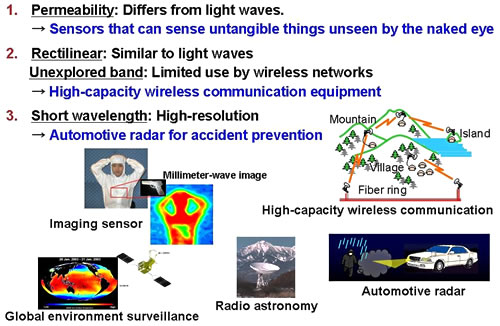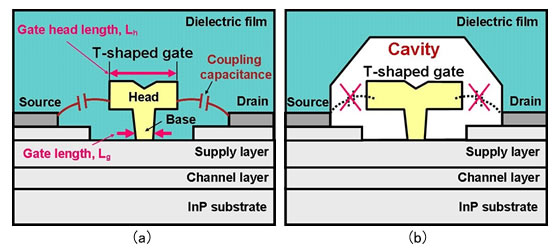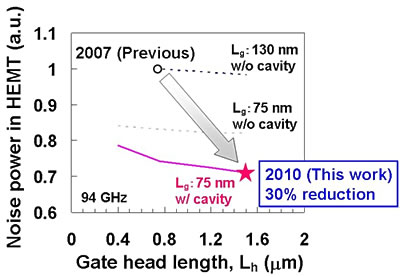Archived content
NOTE: this is an archived page and the content is likely to be out of date.
Fujitsu Develops World's Highest-Performance Ultra-Low-Noise Transistor for Millimeter-Band Receivers
Reduces image capture time of image sensors by half; helps to close the digital divide
Fujitsu Limited,Fujitsu Laboratories Ltd.
-
[1] Indium-phosphide high electron-mobility transistor (InP HEMT)
Invented in 1979 by Fujitsu Laboratories researcher Takashi Mimura (currently a Fellow at Fujitsu Laboratories Ltd.), this is a transistor made of compound semiconductors featuring excellent speed and noise characteristics. Using an indium-phosphide (InP) substrate results in higher speed and lower noise than with conventional gallium-arsenide. This is considered useful in high-speed communications and millimeter-band image sensors.
-
[2] 94 GHz
Gigahertz (GHz) is a unit for measuring frequency, and 1 GHz equals 1 billion hertz. The 94 GHz band and 35 GHz band are currently used primarily in image sensors.
-
[3] Approximately 30% reduction compared to previous technologies
Compared to performance of InP HEMT technology announced by Fujitsu on June 7, 2007 (in Japanese only) and presented at International Microwave Symposium 2007 (IMS 2007).
-
[4] Image sensors
Pertaining to heat noise radiated by objects, image sensors are systems for capturing image data from objects by receiving millimeter-band (primarily 35 GHz band or 94 GHz band) signals in the form of heat radiated by objects.
-
[5] Digital divide
Refers to economic differences between those people or regions with good access to information and communications technology, versus those people or regions with poor access.
-
[6] T-shaped gate
A gate with an electrode in the shape of a "T" when viewed in cross-section. The base, which is the part touching the semiconductor, is made extremely narrow through miniaturization fabrication processes, enabling the transistor to operate at extremely high speeds, while the upper portion is thick to reduce total gate resistance, thereby combining the benefits of both high speed and low signal noise.
-
[7] Nanometer
A unit of length, with 1 nanometer (nm) equal to 1 one-millionth of a millimeter.
-
[8] Noise figure (NF)
The weakest input power level able to be used by an amplifier. When this value is small and a high signal amplification rate is used in the front-end of an amplifier, the impact of the noise figure after passing through the front-end is reduced, enabling receivers with sensitive signal reception.
About Fujitsu
Fujitsu is a leading provider of ICT-based business solutions for the global marketplace. With approximately 170,000 employees supporting customers in 70 countries, Fujitsu combines a worldwide corps of systems and services experts with highly reliable computing and communications products and advanced microelectronics to deliver added value to customers. Headquartered in Tokyo, Fujitsu Limited (TSE:6702) reported consolidated revenues of 4.6 trillion yen (US$50 billion) for the fiscal year ended March 31, 2010. For more information, please see: www.fujitsu.com.
About Fujitsu Laboratories
Founded in 1968 as a wholly owned subsidiary of Fujitsu Limited, Fujitsu Laboratories Limited is one of the premier research centers in the world. With a global network of laboratories in Japan, China, the United States and Europe, the organization conducts a wide range of basic and applied research in the areas of Next-generation Services, Computer Servers, Networks, Electronic Devices and Advanced Materials. For more information, please see: http://jp.fujitsu.com/labs/en.
Technical Contacts
![]() Phone: +81(46)250-8244
Phone: +81(46)250-8244
![]() E-mail: kikan-press@ml.labs.fujitsu.com
E-mail: kikan-press@ml.labs.fujitsu.com
Company:Fujitsu Laboratories Ltd.
Company and organization names mentioned herein are trademarks or registered trademarks of their respective owners. Information provided in this press release is accurate at time of publication and is subject to change without advance notice.
Date: 03 June, 2010
City: Tokyo and Kawasaki, Japan
Company:
Fujitsu Limited,
Fujitsu Laboratories Ltd.,
,
,
,



